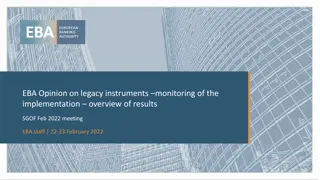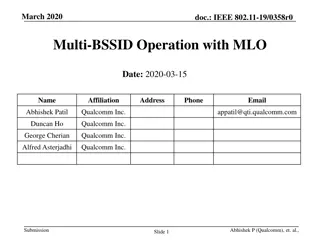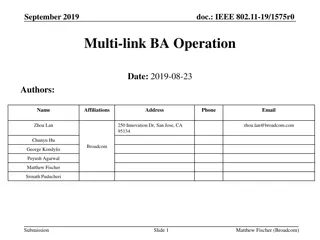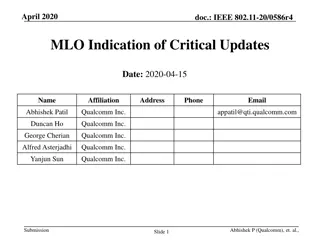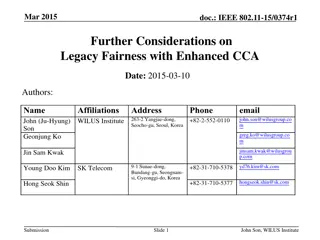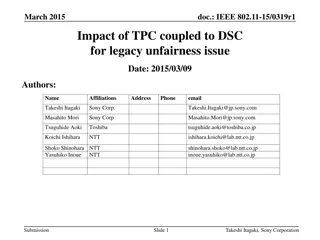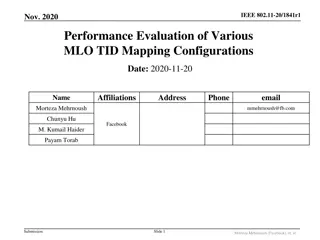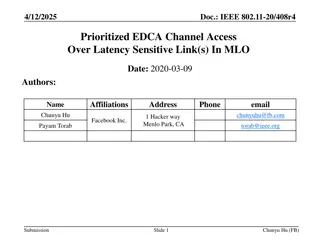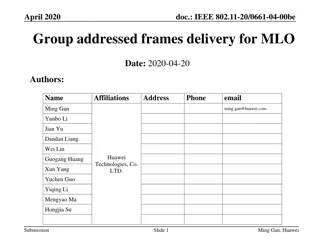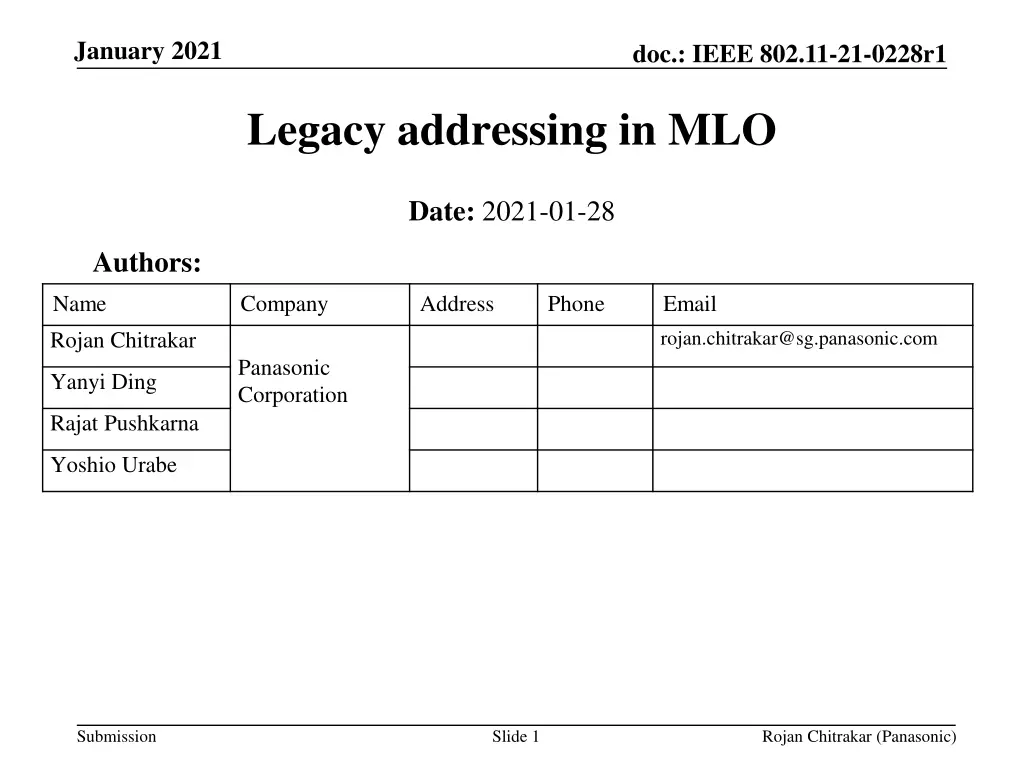
Addressing Issues in IEEE 802.11-21-0228r1 Document
Explore the addressing challenges discussed in the IEEE 802.11-21-0228r1 document, focusing on legacy STA compatibility with MLD MAC addressing and TDLS setup issues. The document delves into concepts like ARP, NDP, and Proxy ARP to highlight ways to address MAC address resolution in complex network scenarios.
Download Presentation

Please find below an Image/Link to download the presentation.
The content on the website is provided AS IS for your information and personal use only. It may not be sold, licensed, or shared on other websites without obtaining consent from the author. If you encounter any issues during the download, it is possible that the publisher has removed the file from their server.
You are allowed to download the files provided on this website for personal or commercial use, subject to the condition that they are used lawfully. All files are the property of their respective owners.
The content on the website is provided AS IS for your information and personal use only. It may not be sold, licensed, or shared on other websites without obtaining consent from the author.
E N D
Presentation Transcript
January 2021 doc.: IEEE 802.11-21-0228r1 Legacy addressing in MLO Date: 2021-01-28 Authors: Name Rojan Chitrakar Company Address Phone Email rojan.chitrakar@sg.panasonic.com Panasonic Corporation Yanyi Ding Rajat Pushkarna Yoshio Urabe Submission Slide 1 Rojan Chitrakar (Panasonic)
January 2021 doc.: IEEE 802.11-21-0228r1 Overview MAC-SAP AP MLD MLD MAC Address AP 2 MAC AP 1 MAC An MLD contains an MLD MAC Address and multiple STA MAC Addresses (one for each affiliated STA). [2] AP1 MAC Address AP2 MAC Address PHY PHY Link 1 Link 2 The TA/RA of frames transmitted over- the-air shall be a STA MAC Address. [2] Link 1 Link 2 PHY PHY PHY MAC MAC MAC STA3 MAC Address STA1 MAC Address STA2 MAC Address An MLD MAC Address singly identifies an MLD. [2] MAC-SAP STA3 STA1 STA2 MLD MAC Address Legacy STA Non-AP MLD MAC-SAP Using MLD MAC address to identify a peer MLD is fine for MLDs or EHT STAs that understand the concept of MLD MAC Address. However, legacy STAs do not understand MLD MAC Address and will have issues when communicating with MLDs especially over peer-to-peer links. [3] Submission Slide 2 Rojan Chitrakar (Panasonic)
January 2021 doc.: IEEE 802.11-21-0228r1 Background [4], [5] provide good background information about Address Resolution Protocol (ARP), Neighbor Discovery Protocol (NDP) and Proxy ARP. ARP/NDP is used to discover a device s MAC Address when its IP address is known. Broadcast: What s the MAC Address for 192.168.1.10? ARP/ND Response ARP/ND Request STA1 192.168.1.0/24 AP Server What s the MAC Address for 192.168.1.10? .1 LAN MAC Address for 0A-20 192.168.1.10 = 00-10 MAC Address for 192.168.1.10 = 00-10 192.168.1.10 00-10 192.168.3.10 0C-40 STA2 If the AP supports Proxy ARP feature, the AP can respond to ARP Request / Neighbor Solicitation messages on behalf of associated STAs and thus helps to significantly reduce broadcast traffic in its BSS. 192.168.1.20 00-20 Illustration of how ARP/ND works without Proxy ARP Submission Slide 3 Rojan Chitrakar (Panasonic)
January 2021 doc.: IEEE 802.11-21-0228r1 Addressing issues in TDLS [3] discusses the addressing issues in TDLS discovery/setup between an MLD and a legacy STA Assumes MLD MAC Address (MLD_S) is set as the TDLS Initiator STA during TDLS Discovery/Setup causing frames on direct link to fail if TA is set as STA MAC Address. [3] Proposes: Setting the TA field to the non-AP MLD s MAC address for frames sent directly to a TDLS peer STA. Using MLD MAC Addresses in the Link Identifier element. Using the MLD MAC address during the TPK handshake. Also implies that RA may be set as MLD MAC Address Assumes MLD MAC Address (MLD_S) is set as TDLS Responder STA in TDLS Discovery Request causing TDLS Discovery Response frame to fail if TA set as STA MAC Address. However, even with the proposed method, the TDLS Setup will fail if the Legacy STA sets the TDLS Responder STA (in TDLS Discovery Request) to STA MAC Address (e.g., STA_1) and the MLD responds with the TA set as MLD MAC Address (MLD_S). Submission Slide 4 Rojan Chitrakar (Panasonic)
January 2021 Discussion It is not clear which MAC Address will be returned by an MLD in response to an ARP/ND request. Is it MLD MAC Address, or one of the STA MAC Addresses? doc.: IEEE 802.11-21-0228r1 MAC-SAP AP MLD MLD MAC Address (AP-MLD-M) ARP/ND Request AP 2 MAC AP 1 MAC ARP/ND Response Beacon AP1 MAC Address (AP1-M) AP2 MAC Address (AP2-M) Data/Management PHY PHY MAC Address? Link 1 Link 2 Using MLD MAC Address to identify an MLD may create confusions for legacy STAs: AP2 s resolved MAC Address (AP- MLD-M) is different from AP2 s BSSID. Non-AP MLD s resolved MAC Address (STA-MLD-M) is different from the MAC Address used in the TA/RA field of OTA frames transmitted/received by the non-AP MLD. AP-MLD-M? TA = STA2-M BSSID = AP2-M MAC Address? Link 1 Link 2 PHY PHY PHY STA-MLD-M? MAC MAC MAC STA3 MAC Address (STA3-M) STA1 MAC Address (STA1-M) STA2 MAC Address (STA2-M) MAC-SAP STA3 STA1 STA2 MLD MAC Address (STA-MLD-M) Legacy STA Non-AP MLD MAC-SAP Submission Slide 5 Rojan Chitrakar (Panasonic)
January 2021 doc.: IEEE 802.11-21-0228r1 Proposal MAC-SAP AP MLD MLD MAC Address (AP-MLD-M) For a legacy STA associated with an AP (AP2) affiliated with an AP MLD: The AP MLD is identified* by the MAC Address of the AP2 (i.e., the BSSID of link 2). E.g., AP2-M. A non-AP MLD that is associated with the AP MLD and that has affiliated STA (STA2) associated with the AP2, is identified with the MAC Address of the STA2 (STA2-M) AP 2 MAC AP 1 MAC AP1 MAC Address (AP1-M) AP2 MAC Address (AP2-M) PHY PHY Link 1 Link 2 Link 1 Link 2 PHY PHY PHY MAC MAC MAC STA3 MAC Address (STA3-M) STA1 MAC Address (STA1-M) STA2 MAC Address (STA2-M) MAC-SAP STA3 STA1 STA2 MLD MAC Address Legacy STA Non-AP MLD MAC-SAP A non-AP MLD that is associated with the AP MLD and does not have any affiliated STAs associated with AP2 may be identified with its MLD MAC Address or with the MAC Address of any of the affiliated STAs. Note: Identified here means the MLD s IP address is mapped to that MAC Address and all over-the-air frames the MLD and the legacy STA use the MAC Address in the address fields. Submission Slide 6 Rojan Chitrakar (Panasonic)
January 2021 doc.: IEEE 802.11-21-0228r1 Proposal For an MLD, or for a device in the DS, a peer MLD is always identified by its MLD MAC Address. (Same as D0.3) When relaying Data frames from an associated non-AP MLD to a legacy STA, an AP MLD shall use the MAC Address of the relevant affiliated STA of the non- AP MLD in the Source Address (A3) field (instead of its MLD MAC Address). When communicating over the air with a legacy STA, an MLD shall use the MAC Address of its relevant affiliated STA in all applicable address fields (instead of its MLD MAC Address): E.g., in the TDLS Initiator STA field in TDLS Discovery/Setup frames. Submission Slide 7 Rojan Chitrakar (Panasonic)
January 2021 doc.: IEEE 802.11-21-0228r1 Solution - Using Proxy ARP Since an AP MLD has records of the MAC Addresses of all associated devices, the proposal can be easily achieved using Proxy ARP service. The AP MLD shall maintain a Hardware Addresses* to Internet Address mapping for each associated station (non-AP MLD or non-AP STA), and shall update the mapping when the Internet Address of the associated non-AP MLD changes. When the IPv4 address being resolved in an ARP request or the IPv6 being resolved in a Neighbor Solicitation message, is used by a station currently associated with the AP MLD, the proxy ARP service shall respond on behalf of the station to the ARP request or the ARP probe or the Neighbor Solicitation message. *The Hardware Addresses of an MLD may be its MLD MAC Address or the MAC Address of one of its affiliated STAs. Submission Slide 8 Rojan Chitrakar (Panasonic)
January 2021 Solution - Using Proxy ARP (IPv4) When an AP MLD receives an ARP request from one associated station or from the DS with a target IP address that corresponds to a second associated non-AP MLD, the AP MLD shall: insert the second non-AP MLD s MLD MAC address as the Sender s MAC Address in the ARP response packet if the associated station is a non-AP MLD or the request is from the DS. insert the MAC address of the affiliated STA of the second non-AP MLD that operates on the link in which the request was received,as the Sender s MAC Address in the ARP response packet if the associated station is not an MLD. doc.: IEEE 802.11-21-0228r1 Submission Slide 9 Rojan Chitrakar (Panasonic)
January 2021 Solution - Using Proxy ARP (IPv6) When an AP MLD receives a Neighbor Solicitation message from one associated station or from the DS with a target IP address that corresponds to a second associated non-AP MLD, the AP MLD shall: insert the second non-AP MLD s MLD MAC address as the Sender s MAC Address in the Neighbor Advertisement Message if the associated station is a non-AP MLD or the request is from the DS. insert the MAC address of the affiliated STA of the second non-AP MLD that operates on the link in which the request was received, as the Sender s MAC Address in the Neighbor Advertisement Message if the associated station is not an MLD. doc.: IEEE 802.11-21-0228r1 Submission Slide 10 Rojan Chitrakar (Panasonic)
January 2021 doc.: IEEE 802.11-21-0228r1 Solution - Using Proxy ARP Example 1: Resolving non-AP MLD1 s IP Address LAN Ethernet AP-MLD-IP AP-MLD-M Link1: 5 GHz 1a) STA-MLD1-IP s MAC Address? Ethernet I/F Link2: 6 GHz AP MLD ARP/ND Request 1b) STA-MLD1-IP s MAC Address = STA-MLD1-M AP1 AP2 AP2-M AP1-M ARP/ND Response 2a) STA-MLD1-IP s 3b) STA-MLD1-IP s MAC Address = STA1-M 3a) STA-MLD1-IP s MAC Address? 2b) STA-MLD1-IP s MAC Address MAC Address? = STA-MLD1-M (b0=1) STA2-M STA1 STA2 STA1-M STA4-M STA3 STA4 STA3-M Non-AP MLD1 STA-MLD1-IP STA-MLD1-M Non-AP MLD2 STA5 STA-MLD2-IP STA-MLD2-M STA5-IP STA5-M Submission Slide 11 Rojan Chitrakar (Panasonic)
January 2021 Solution Further Considerations doc.: IEEE 802.11-21-0228r1 3 Octets 3 Octets Network Interface Controller (NIC) Specific Organisationally Unique Identifier (OUI) 1 2 3 4 5 6 b7 b6 b5 b4 b3 b2 b1 b0 b0 (Individual/Group bit) may be used to differentiate MLD MAC Address When the requesting station is a non-AP MLD, the AP MLD sets the Individual/Group bit (b0) of the Sender s MAC address to differentiate between the STA MAC Address and the MLD MAC address of an associated non-AP MLD: b0 is set to 0 to indicate STA MAC Address b0 is set to 1 to indicate MLD MAC Address Note: If the b0 bit is set to 1 in a resolved MAC Address, the receiving MLD is informed that the target device is an MLD; else it is a legacy STA. The MLD needs to recover the original MLD MAC Address by setting b0 bit to 0. Due to the broadcast frame reduction effect [5], we also propose that implementation of the proxy ARP service shall be mandatory for an AP MLD that supports legacy association. All the APs affiliated with the AP MLD shall set the Proxy ARP field to 1 in the Extended Capabilities element. Submission Slide 12 Rojan Chitrakar (Panasonic)
January 2021 Example 2: Non-AP MLD initiated TDLS setup with legacy STA doc.: IEEE 802.11-21-0228r1 STA-MLD2-IP STA-MLD2-M AP-MLD-IP AP-MLD-M Link1: 5 GHz Non-AP MLD2 AP MLD STA5-IP STA5-M Link2: 6 GHz STA5 STA4 STA4-M STA3 STA3-M AP2-M AP1 AP2 AP1-M ARP Request 802.11 Data frame AP MLD provides the STA MAC Address as the hardware address. b0 = 0 informs that this is not an MLD MAC Address RA = TA = DA = Src. Hw = STA-MLD2-M Src. IP = Target Hw = Broadcast Target IP = STA5-IP STA4 Sends ARP Request to resolve STA5-IP AP2-M STA4-M Broadcast STA-MLD2-IP Since the Target is an associated STA, AP MLD resolves the IP address on behalf of the Target (STA5). ARP Reply 802.11 Data frame RA = TA = SA = Src. Hw = STA5-M Src. IP = STA5-IP Target Hw = STA-MLD2-M Target IP = STA-MLD2-IP Non-AP MLD2 updates its ARP cache with: (STA5-IP <> STA5-M) STA4-M AP2-M AP2-M STA4-M is used as the TDLS Initiator since the peer-STA is known to be non-MLD. AP sets SA as the STA MAC Address TDLS Discovery Request (Link Id. IE) 802.11 Data frame Non-AP MLD2 initiate TDLS Discovery to STA5 via the AP MLD. Since it is aware that STA5 is a legacy STA, STA MAC address (STA4-M) is used in the TDLS initiator field BSSID = AP2-M TDLS Initiator = STA4-M RA = TA = DA = TDLS Responder = STA5-M AP2-M STA4-M STA5-M AP-MLD forwards the Data frame received from STA5 to non-AP- MLD2 via AP2. AP- MLD maps SA from STA-MLD2-M to STA4- M such that SA = TDLS Initiator TDLS Discovery Request (Link Id. IE) 802.11 Data frame Frame transmitted via the AP MLD is correctly received. RA = TA = SA = BSSID = AP2-M TDLS Initiator = STA4-M TDLS Responder = STA5-M STA5-M AP2-M STA4-M Link Id. IE 802.11 Public Action frame STA5 sends the TDLS Discovery Response frame via the direct path TDLS Discovery Response Action frame TA = BSSID = AP2-M TDLS Initiator = STA4-M TDLS Responder = STA5-M RA = STA4-M BSSID = AP2-M STA5-M RA is correctly set as the STA MAC Address IP Packet Frames on direct link are correctly received since the RA is set as the STA s MAC Address! 802.11 Data frame RA = TA = BSSID = AP2-M Src. IP = Target IP = STA5-IP Data frame STA5-M STA4-M STA-MLD2-IP 802.11 Data frame IP Packet RA = TA = BSSID = AP2-M Src. IP = STA5-IP Target IP = STA-MLD2-IP Data frame STA4-M STA5-M Submission Slide 13 Rojan Chitrakar (Panasonic)
January 2021 Example 3: Legacy STA initiated TDLS setup with non-AP MLD doc.: IEEE 802.11-21-0228r1 STA-MLD2-IP STA-MLD2-M Link1: 5 GHz AP-MLD-IP AP-MLD-M Link2: 6 GHz Non-AP MLD2 AP MLD STA4 STA4-M STA3 STA3-M STA5-M STA5 AP1-M AP2-M AP1 AP2 Neighbor Solicitation Message 802.11 Data frame RA = TA = DA = Target Address = STA-MLD2-IP Source L2 Address = STA5-M STA5 Sends ND message to resolve STA-MLD2-IP Since the Target is an associated STA, AP MLD resolves the IP address on behalf of the Target (non-AP MLD2). Since AP MLD is aware that the requesting STA (STA5) is a legacy STA, it provides STA Address corresponding to the link of STA5 instead of the MLD MAC Address. Type = 135 AP MLD provides the STA MAC Address as the hardware address. AP2-M STA5-M Broadcast Neighbor Advertisement Message STA5 updates its neighbor cache with: (STA-MLD2-IP <> STA4-M) 802.11 Data frame RA = TA = SA = Target Address = STA-MLD2-IP Target L2 Address = STA4-M Type = 136 STA5-M AP2-M AP2-M STA5 initiate TDLS Discovery to non-AP MLD2 via the AP MLD. STA MAC address (STA5-M, STA4-M) are used as in the DA, SA fields as well as the TDLS responder field. DA = TDLS Responder STA4-M is used as the TDLS Responder. TDLS Discovery Request (Link Id. IE) 802.11 Data frame BSSID = AP2-M TDLS Initiator = STA5-M RA = AP2-M / STA4-M TA = DA / SA = STA4-M / STA5-M TDLS Responder = STA4-M STA5-M / AP2-M Frame transmitted via the AP MLD is correctly received. AP-MLD forwards the Data frame received from STA5 to STA4 via AP2. Link Id. IE 802.11 Public Action frame Non-AP MLD2 sends the TDLS Discovery Response frame via the direct path. TA = TDLS Responder TDLS Discovery Response Action frame RA = TA = BSSID = AP2-M TDLS Initiator = STA5-M TDLS Responder = STA4-M AP sets SA as the STA MAC Address BSSID = AP2-M STA5-M STA4-M TDLS Setup Request (Link Id. IE) 802.11 Data frame STA5 initiate TDLS Setup with STA4 via the AP MLD. DA = TDLS Responder BSSID = AP2-M TDLS Initiator = STA5-M RA = AP2-M / STA4-M TA = DA / SA = STA4-M / STA5-M TDLS Responder = STA4-M STA5-M / AP2-M AP-MLD forwards the Data frame received from STA5 to STA4 via AP2. STA4 sends TDLS Setup Response to STA5 via the AP MLD. DA = TDLS Initiator TDLS Setup Response (Link Id. IE) 802.11 Data frame BSSID = AP2-M TDLS Initiator = STA5-M RA = AP2-M / STA5-M TA = DA / SA = STA5-M / STA4-M TDLS Responder = STA4-M AP-MLD forwards the Data frame received from STA4 to STA5 via AP2. AP2 sets the SA to STA4-M. SA = TDLS Responder RA/TA correctly set as the STA MAC Address STA4-M / AP2-M Frames on direct link are correctly received since the RA is set as the STA s MAC Address! IP Packet 802.11 Data frame RA = TA = BSSID = AP2-M Src. IP = STA5-IP / STA-MLD2-IP Target IP = STA-MLD2-IP / STA5-IP Data frame STA4-M / STA5-M STA5-M / STA4-M Submission Slide 14 Rojan Chitrakar (Panasonic)
January 2021 doc.: IEEE 802.11-21-0228r1 Conclusion In this contribution, we discussed the MLO addressing issues from a legacy STA s perspectives. We proposed modifying the Proxy ARP services in AP MLD such that: For a legacy STA, an MLD s IP address is mapped to one of its affiliated STA s MAC Address. AP MLD helps to differentiate whether a resolved MAC Address is a STA MAC Address or an MLD MAC address (e.g., using the b0 (Individual/Group bit)). We showed that the address mismatch issues raised in [3] may be solved without requiring the RA/TA to be set as MLD MAC Addresses. Submission Slide 15 Rojan Chitrakar (Panasonic)
January 2021 doc.: IEEE 802.11-21-0228r1 References 1) IEEE 802.11-20/1935r13 compendium-of-straw-polls- and-potential-changes-to-the-specification-framework- document-part-2 2) Draft P802.11be_D0.3 3) IEEE 802.11-20/1692r2 tdls-handling-in-mlo 4) IEEE 802.11-20/1750r0 proxy-arp-service-in-mlo 5) IEEE 802.11-15/1015-01 proxy-arp-in-802-11ax Submission Slide 16 Rojan Chitrakar (Panasonic)
January 2021 doc.: IEEE 802.11-21-0228r1 Straw Poll 1 Do you support the following proxy ARP service in R1? When an AP MLD receives an ARP request from one associated station or from the DS with a target IP address that corresponds to a second associated non-AP MLD, the AP MLD shall: o insert the second non-AP MLD s MLD MAC address as the Sender s MAC Address in the ARP response packet if the associated station is a non-AP MLD or the request is from the DS. o insert the MAC address of the affiliated STA of the second non- AP MLD that operates on the link in which the request was received, as the Sender s MAC Address in the ARP response packet if the associated station is not an MLD. Y/N/A Submission Slide 17 Rojan Chitrakar (Panasonic)
January 2021 doc.: IEEE 802.11-21-0228r1 Straw Poll 2 Do you support the following proxy ARP service in R1? When an AP MLD receives a Neighbor Solicitation message from one associated station or from the DS with a target IP address that corresponds to a second associated non-AP MLD, the AP MLD shall: o insert the second non-AP MLD s MLD MAC address as the Sender s MAC Address in the Neighbor Advertisement Message if the associated station is a non-AP MLD or the request is from the DS. o insert the MAC address of the affiliated STA of the second non- AP MLD that operates on the link in which the request was received, as the Sender s MAC Address in the Neighbor Advertisement Message if the associated station is not an MLD. Y/N/A Submission Slide 18 Rojan Chitrakar (Panasonic)
January 2021 doc.: IEEE 802.11-21-0228r1 Straw Poll 3 Do you support the following proxy ARP service in R1? When a requesting station is an associated non-AP MLD, the AP MLD shall set the Individual/Group bit (b0) of the Sender s MAC address in an ARP response packet or a Neighbor Advertisement Message to differentiate between the MAC Address of an affiliated STA and the MLD MAC address of the second non-AP MLD: o b0 is set to 0 to indicate STA MAC Address o b0 is set to 1 to indicate MLD MAC Address Note: If the b0 bit is set to 1 in a resolved MAC Address, the receiving MLD is informed that the target device is an MLD; else it is a legacy STA. The MLD needs to recover the original MLD MAC Address by setting b0 bit to 0. Y/N/A Submission Slide 19 Rojan Chitrakar (Panasonic)
January 2021 doc.: IEEE 802.11-21-0228r1 Straw Poll 4 Do you support the following proxy ARP service in R1? Implementation of the proxy ARP service shall be mandatory for an AP MLD that supports legacy association. All the APs affiliated with the AP MLD shall set the Proxy ARP field to 1 in the Extended Capabilities element. Y/N/A Submission Slide 20 Rojan Chitrakar (Panasonic)
January 2021 doc.: IEEE 802.11-21-0228r1 Straw Poll 5 Do you support the following AP MLD behavior in R1? When relaying Data frames from an associated non-AP MLD to an associated legacy STA, an AP MLD shall use the MAC Address of the relevant affiliated STA of the non-AP MLD in the Source Address (A3) field (instead of the non-AP MLD s MLD MAC Address). Y/N/A Submission Slide 21 Rojan Chitrakar (Panasonic)
January 2021 doc.: IEEE 802.11-21-0228r1 Straw Poll 6 Do you support the following AP MLD behavior in R1? When communicating over the air with a legacy STA, an MLD shall use the MAC Address of its relevant affiliated STA in all applicable address fields (instead of the non-AP MLD s MLD MAC Address): Note: applicable address fields may be the TDLS Initiator STA field in TDLS Discovery/Setup frames, the TA/RA fields in all frames. Y/N/A Submission Slide 22 Rojan Chitrakar (Panasonic)
January 2021 doc.: IEEE 802.11-21-0228r1 Annex I 21/240 suggest the following: If the TDLS responder is a non-AP MLD, then the TDLS responder STA Address field contained in the Link Identifier element of the TDLS Discovery Response frame or TDLS Setup Response frame shall be set to the MAC address of the non-AP MLD. If a legacy STA initiates TDLS Discovery/Setup using the STA MAC Address of an affiliated STA as the TDLS Responder STA Address, the above rule will cause the legacy STA to reject the corresponding TDLS Response frame due to the mismatch in the TDLS Responder STA Address. STA-MLD1-IP STA-MLD1-M AP-MLD-IP AP-MLD-M Non-AP MLD1 AP MLD STA2 STA2-M STA1 STA1-M STA5-M STA5 AP1-M AP2-M AP1 AP2 STA5 initiate TDLS Discovery to non-AP MLD1 via the AP MLD. STA MAC address (STA5-M, STA2-M) are used in the DA, SA fields as well as the TDLS responder field. DA = TDLS Responder TDLS Discovery Request (Link Id. IE) 802.11 Data frame BSSID = AP2-M TDLS Initiator = STA5-M TDLS Responder = STA2-M RA = AP2-M TA = STA5-M DA= STA2-M AP-MLD forwards the Data frame received from STA5 to STA2 via AP2. TDLS Discovery Request (Link Id. IE) 802.11 Data frame BSSID = AP2-M TDLS Initiator = STA5-M TDLS Responder = STA2-M RA = STA2-M TA = AP2-M SA = STA5-M Non-AP MLD1 sends the TDLS Discovery Response frame via the direct path. TA = TDLS Responder Link Id. IE 802.11 Public Action frame TDLS Discovery Response Action frame RA = TA = STA- MLD1-M BSSID = AP2-M TDLS Initiator = STA5-M TDLS Responder = STA-MLD1-M BSSID = AP2-M STA5-M Mismatch in the TDLS Responder STA Address Submission Slide 23 Rojan Chitrakar (Panasonic)


